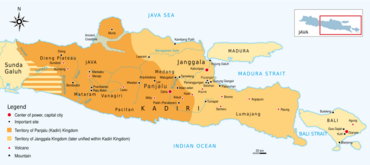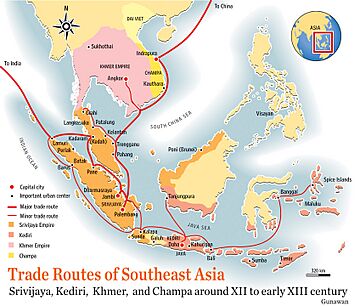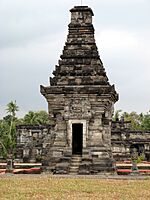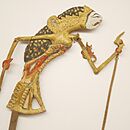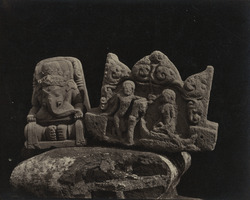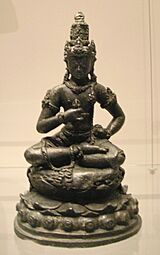Kediri Kingdom facts for kids
Quick facts for kids
Kediri Kingdom
Pañjalu 1042–1222 ꦥꦚ꧀ꦗꦭꦸ (Javanese) Gelang-Gelang Kingdom Gégélang 1292 - 1293 ꦒꦺꦒꦺꦭꦁ (Javanese) |
|||||||||||
|---|---|---|---|---|---|---|---|---|---|---|---|
| 1042–1293 | |||||||||||
|
Janggala and Panjalu later unified as Kediri kingdom
|
|||||||||||
| Capital | Dahanapura (modern Kediri) | ||||||||||
| Common languages | Old Javanese, Sanskrit | ||||||||||
| Religion | Hinduism, Buddhism, Animism | ||||||||||
| Government | Monarchy | ||||||||||
| Maharaja | |||||||||||
|
• 1042–1051
|
Samaravijaya | ||||||||||
|
• 1194–1222
|
Kertajaya | ||||||||||
|
• 1292–1293
|
Jayakatwang | ||||||||||
| History | |||||||||||
| 1042 | |||||||||||
|
• Janggala conquered
|
1135 | ||||||||||
|
• Kakawin Bharatayuddha finished writing
|
1157 | ||||||||||
| 1222 | |||||||||||
| 1292 | |||||||||||
| 1293 | |||||||||||
| Currency | Native gold and silver coins | ||||||||||
|
|||||||||||
The Kediri Kingdom (also known as Pañjalu) was an important kingdom on the island of Java. It existed from 1042 to 1222. For a short time (1292–1293), it was revived under King Jayakatwang. This kingdom was a center for both Hinduism and Buddhism.
Kediri was located in East Java, with its capital city called Dahanapura. This city is near what is now Kediri city. Even though not many old buildings remain, the Kediri era was famous for its amazing literature. Famous Javanese stories like Kakawin Bharatayuddha were written during this time.
Contents
What Does "Kediri" Mean?
The capital city, Daha, existed before the kingdom was founded. Daha is short for Dahanapura, which means "city of fire." This name was used in old writings from 1042.
Panjalu: The Twin Kingdom
The Kediri Kingdom was also known as Panjalu. It was once a twin kingdom with Janggala. The name Panjalu was often used in old inscriptions. Chinese records from 1178 also called it "Pu-chia-lung."
The word "Pangjalu" comes from "Jalu," meaning "male" or "strong." In this context, it means a fertile and independent area. The word "Kadiri" means something similar: "able to stand alone" or "independent."
Kadiri: The Mulberry Tree
Another idea for the name "Kadiri" comes from the Sanskrit word Khadri. This word means "India Mulberry," a tree known locally as pacé or mengkudu. This tree's bark was used for dyes, and its fruit had medicinal uses.
How Kediri Kingdom Started
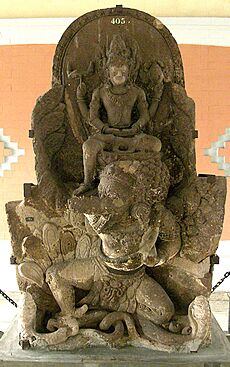
The Kediri Kingdom was a continuation of the earlier Kahuripan kingdom, ruled by King Airlangga. In 1042, King Airlangga decided to divide his kingdom into two parts: Janggala and Panjalu (which became Kediri). He did this for his two sons and then chose to live a simple life as a holy man.
Who Were the Kings of Kediri?
The first king of Kediri that we have records about was Maharaja Çri Samaravijaya (1042–1051). His royal symbol was the Garudmukha, a mythical bird, just like King Airlangga's.
King Jayabhaya and His Prophecies
Jayabhaya (1135–1157) was a very famous king. His royal symbol showed Lord Vishnu as Narasinghavatara, a human with a lion's head. During his rule, the famous Javanese version of the Mahabharata, called Kakawin Bharatayuddha, was written. This was a golden age for Javanese literature.
King Jayabhaya is also known for his prophecies, called the Prelambang Joyoboyo. These predictions are still well-known among Javanese people. They talk about future rulers and a "Just Prince" (Ratu Adil) who will bring good times.
Other Important Kings
- Çri Sarwweçwara (1159–1171) followed Jayabhaya. His symbol was a nine-winged shape.
- Çri Aryyeçwara (1171–1181) used Ganesha, the elephant-headed god, as his royal symbol.
- King Gandra (1181–1182) had an inscription that showed officials were given animal names like "White Tiger" or "Yellow Elephant." This also suggests Kediri had a navy!
- Kameçvara (1182–1194) was known for the story Smaradhana. In this story, the king was seen as the god of love, Kamajaya, and his wife, Çri Kirana, as the goddess Kamaratih. These stories, called the Panji cycle, became popular across Southeast Asia.
The Last King: Kertajaya
The last king of Kediri was Kritajaya or Kertajaya (1194–1222). His royal symbol featured a conch shell with two horns. In 1222, he was defeated by Ken Arok from Tumapel in the Battle of Genter. This battle ended the Kediri Kingdom and started the new Singhasari era.
Kediri's Golden Age
How Kediri Connected with Other Countries
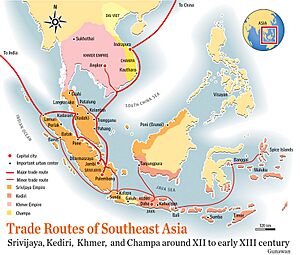
The Kediri Kingdom existed at the same time as the powerful Srivijaya empire in Sumatra. Kediri had strong trade links with China and some connections with India. Chinese records called Java "Tsao-wa" or "Chao-wa," showing that Chinese traders often visited the kingdom.
In the 11th century, Srivijaya's power began to weaken. This allowed new kingdoms like Kediri to grow. Kediri became strong through farming and later by controlling the spice trade routes to the Maluku Islands.
A Chinese book from 1225, Chu-fan-chi, described Java (Kediri) as a rich and powerful kingdom. It said that people in Java followed both Buddhism and Hinduism. They were brave and enjoyed activities like cockfighting. Their money was made from copper, silver, and tin.
The book also listed many places that Kediri ruled or influenced, including parts of Sumatra, Bali, Timor, and even areas in Papua.
Daily Life and Culture
The Kediri era was famous for its literature. Besides the stories mentioned earlier, other important works like Śiwarātrikalpa and Krisnayana were also written.
A Chinese author named Chou K'u-fei wrote about daily life in Kediri in 1178. He said people wore long clothes and had loose hairstyles. Their homes were clean, with floors made of stone. Farming, animal raising, and trade were very important. People even raised silkworms to make silk and cotton clothes.
Instead of putting criminals in jail, people who broke laws had to pay fines in gold. However, thieves and robbers were executed. When people got married, the groom's family gave a "bride price" to the bride's family. For health problems, people in Kediri often relied on prayers to Buddha instead of medical treatments.
People celebrated festivals. In the fifth month, they had a water festival, traveling in boats on the river. In the tenth month, they had a mountain festival with music played on flutes, drums, and wooden xylophones (an early form of gamelan).
The King wore silk clothes, leather shoes, and fancy gold jewelry. When the king traveled outside his palace, he rode an elephant. He was joined by 500–700 soldiers and officials. People would bow down as he passed by.
How Kediri Made Money
The people of Kediri mainly focused on farming (especially rice), raising animals like cattle and poultry, and trading spices. The capital city, Daha, was located inland near the fertile Brantas river valley. Kediri used good irrigation systems, including a dam, inherited from earlier kingdoms. They also used silver coins for trade.
Over time, Kediri's economy relied more on trade, especially the spice trade. They built a navy, which helped them control the spice routes to the eastern islands. Kediri collected spices from places like southern Kalimantan and the Maluku Islands. These spices were then sent to markets in India, China, and the Mediterranean through the famous Spice Route.
The End of Kediri Kingdom
The Fall of the First Kingdom
The Kediri Kingdom ended under King Kertajaya. He had conflicts with the brahmins (religious scholars). The brahmins asked for help from Ken Arok, a powerful leader from Tumapel. Ken Arok also wanted to free Tumapel from Kediri's rule.
In 1222, Ken Arok's troops defeated King Kertajaya's army in the Battle of Genter. This battle marked the end of the first Kediri Kingdom. Kediri then became a part of the new Singhasari Kingdom. Ken Arok appointed Kertajaya's son, Jayasabha, to rule Kediri as a local leader.
Jayakatwang's Rebellion
In 1292, a leader named Jayakatwang rebelled against the Singhasari Kingdom. He was a descendant of King Kertajaya and wanted revenge for his ancestor's defeat. Jayakatwang successfully killed the Singhasari king, Kertanegara, and briefly brought the Kediri Kingdom back to life.
However, this revived Kediri Kingdom lasted only one year. It was attacked by a combined force of Mongol troops and the army of Raden Wijaya. Raden Wijaya later founded the powerful Majapahit Kingdom.
A Brief Return of Daha
Much later, at the very end of the Majapahit era in the 15th century, the city of Daha (Kediri) briefly became a center of power again. This happened when Girindrawardhana defeated the Majapahit king in 1478. But this revival was also short-lived. The new Sultanate of Demak crushed Daha in 1527, ending its final return to power.
Kings of Kediri
| Years of Rule | King/Maharaja | Important Events and Records |
|---|---|---|
| 1042–1051 | Çri Samaravijaya | Became king after King Airlangga divided his kingdom. |
| 1051–1112 | Çri Jitendrakara | Mentioned in the Mataji inscription (1051). |
| 1112–1135 | Çri Bamesvara | Many inscriptions from his rule show development in East Java. |
| 1135–1159 | Jayabaya | Famous for the Kakawin Bharatayuddha and his prophecies. |
| 1159–1171 | Çri Sarvesvara | Mentioned in the Kahyunan and Padlegan II inscriptions. |
| 1171–1181 | Çri Aryesvara | Used Ganesha as his royal symbol. |
| 1181–1182 | Çri Gandra | Officials were given animal names; Kediri likely had a navy. |
| 1182–1194 | Kameçvara | The Smaradhana story was written during his reign. |
| 1194–1222 | Kertajaya | Lost to Ken Arok in the Battle of Ganter in 1222, ending the first Kediri Kingdom. |
| Jayakatwang briefly brought the Kediri Kingdom back to life. | ||
| 1292–1293 | Jayakatwang | Rebelled against Singhasari but was defeated by Mongol and Majapahit forces. |
See also
- List of monarchs of Java


